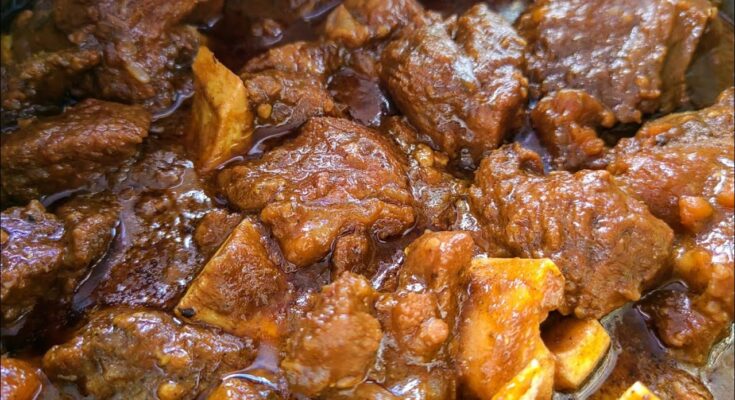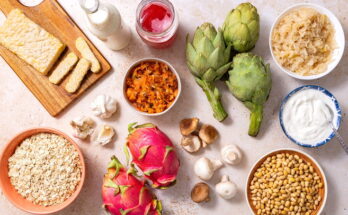Stew Recipe: There’s nothing like a warm, hearty stew to bring comfort on a chilly day. Stews have been a staple in culinary traditions around the globe, cherished for their ability to transform simple ingredients into something extraordinary.
Whether you’re looking for a dish to impress or just craving a wholesome meal, this step-by-step guide will help you create the perfect stew every time.
Let’s dive into the magic of slow-cooked flavors!
Ingredients for a Perfect Stew
Core Ingredients Needed
To craft a delicious stew, you’ll need the following:
- Meat Options: Choose from beef, chicken, lamb, or a vegetarian substitute like tofu or jackfruit.
- Vegetables: Carrots, potatoes, onions, celery, and garlic are essential. Add parsnips or mushrooms for extra depth.
- Spices and Herbs: Think bay leaves, thyme, rosemary, paprika, and a touch of black pepper.
Optional Add-Ons
- A splash of red wine for a richer broth.
- Tomato paste for added tanginess.
- Beans or lentils to increase protein.
Tools You’ll Need
Essential Cookware
- A Dutch oven for even heat distribution.
- A slow cooker for set-it-and-forget-it convenience.
- A large stockpot if you prefer stovetop cooking.
Utensils for Preparation
- Cutting board and sharp knife for precise chopping.
- Wooden spoon for stirring.
- Measuring cups for accuracy.
Preparing the Ingredients
Cutting and Prepping the Meat
Trim any excess fat from the meat and cut it into bite-sized chunks. This ensures uniform cooking.
Washing and Chopping Vegetables
Peel and dice your vegetables into evenly sized pieces for consistent texture. Rinse them thoroughly to remove any dirt.
Measuring Spices and Herbs
Organize your spices beforehand to streamline the cooking process. Pre-measured ingredients can prevent over-seasoning.
Step 1: Browning the Meat
Browning the meat is the secret to a flavorful stew. Heat oil in your pot, then add the meat in small batches to avoid overcrowding. Let it develop a golden crust on all sides. This step locks in the juices and creates a base for your stew’s depth of flavor.
Step 2: Sautéing the Aromatics
After removing the browned meat, toss in your aromatics like onions, garlic, and celery. Cook them until they’re softened and fragrant. This process releases essential oils and enhances the overall taste of your stew.
Step 3: Building the Base
Pour in your liquids—whether it’s a rich beef broth, chicken stock, or vegetable broth. Add a splash of wine if desired. Stir in your spices and herbs at this stage to infuse the liquid with flavor. Bring everything to a gentle simmer.
Step 4: Slow Cooking the Stew
Transfer your pot to a slow cooker or reduce the heat on your stovetop. Slow cooking allows the flavors to meld beautifully. For stovetop cooking, keep the pot partially covered. This ensures the stew thickens while retaining moisture.
Step 5: Adding Vegetables at the Right Time
Vegetables can easily overcook, turning mushy if added too early. Start with hardy options like carrots and potatoes. Add delicate ones like peas or green beans closer to the end of the cooking process.
Step 6: Seasoning to Taste
Once your stew has simmered for a while, it’s time to taste and adjust the seasoning. Start with a pinch of salt and a few grinds of black pepper, then gradually build up the flavor. Taste testing is key here—every stew can benefit from a personalized touch. If you find the flavor too mild, try adding a pinch of paprika, a splash of Worcestershire sauce, or even a squeeze of lemon for brightness.
Pro Tips for Seasoning
- If the stew tastes too salty, balance it out with a small amount of sugar or a splash of vinegar.
- Always season gradually; you can always add more, but you can’t take it out.
Step 7: Thickening the Stew
For a rich, velvety texture, you’ll want to thicken the stew. Here are some popular methods:
Using Flour or Cornstarch
- Create a slurry by mixing a tablespoon of flour or cornstarch with cold water. Stir it into the stew and let it simmer until thickened.
- For a gluten-free option, arrowroot powder works just as well.
Mashing Vegetables
- Mash a few potatoes or carrots directly in the pot to naturally thicken the broth.
Other Methods
- Adding a dollop of cream or coconut milk for a creamy texture.
- Reducing the stew on low heat to concentrate the flavors and thicken the broth naturally.
Step 8: Final Simmer and Serving
Before serving, allow the stew to simmer gently for another 10-15 minutes. This resting period helps the flavors deepen and meld together beautifully. Remove any bay leaves or herb stems at this stage.
Garnishing Tips
- Sprinkle fresh parsley, chives, or a dash of grated Parmesan for an elegant finish.
- Serve with crusty bread, rice, or mashed potatoes for a complete meal.
Popular Variations of Stews
Beef Stew
A classic choice featuring tender chunks of beef, carrots, and potatoes, all slow-cooked in a savory broth. A splash of red wine adds depth to this hearty dish.
Chicken Stew
Light and flavorful, chicken stew combines tender chicken with vegetables like celery and mushrooms in a herbed broth. Perfect for a weeknight dinner.
Vegetarian Stew
Packed with lentils, chickpeas, or tofu, this plant-based version doesn’t skimp on flavor. Use vegetable broth and an array of colorful vegetables for a nutrient-rich dish.
Storing and Reheating Leftovers
Storage Tips
- Let the stew cool completely before transferring it to airtight containers.
- Refrigerate for up to 4 days or freeze for up to 3 months.
Reheating Instructions
- For best results, reheat the stew slowly on the stovetop over low heat, stirring occasionally.
- If reheating in the microwave, cover the bowl to prevent splatters and stir halfway through to ensure even heating.
Tips for Perfect Stew Every Time
Common Mistakes to Avoid
- Overcrowding the pot during browning: This prevents the meat from searing properly.
- Adding too much liquid: A good stew should be thick and hearty, not soupy.
- Forgetting to taste and adjust: Stews require periodic flavor checks.
Expert Tricks
- Layering Flavors: Build complexity by adding spices, herbs, and liquids in stages.
- Patience Pays Off: The longer you let your stew simmer, the better the flavors will develop.
FAQs About Stew Recipe
What is a stew?
A stew is a hearty dish made by simmering meat, vegetables, and seasonings in a liquid base, typically broth or stock. It’s a comfort food loved for its rich flavors and versatility.
What are the key ingredients for a stew?
Common ingredients include meat (such as beef, chicken, or lamb), root vegetables (like carrots and potatoes), onions, garlic, and a flavorful liquid like stock or wine. Herbs and spices enhance the flavor.
How long does it take to make a stew?
The cooking time varies depending on the recipe, but most stews require 1-2 hours of simmering to achieve tender meat and a rich, flavorful broth.
Can I make a vegetarian stew?
Yes, vegetarian stews can be made using beans, lentils, tofu, or hearty vegetables like mushrooms and squash. Vegetable broth works well as a base.
What’s the best way to thicken a stew?
You can thicken a stew by simmering it longer, adding a flour or cornstarch slurry, or mashing some of the cooked vegetables into the broth.
How should I store leftover stew?
Allow the stew to cool completely, then store it in an airtight container in the refrigerator for up to 3-4 days. For longer storage, freeze it for up to 3 months.
Can I reheat stew without losing flavor?
Yes, reheat the stew on low heat on the stovetop, stirring occasionally to maintain its flavor and texture. Adding a splash of broth or water can help restore its consistency.
Conclusion
Making a stew is an art that’s as rewarding as it is delicious. From browning the meat to slow cooking the ingredients, every step contributes to a meal that’s hearty, flavorful, and comforting. Whether you’re crafting a traditional beef stew, experimenting with chicken, or going vegetarian, this guide ensures you’ll achieve perfection every time. So grab your pot and get started—you’re just a few steps away from stew bliss!



